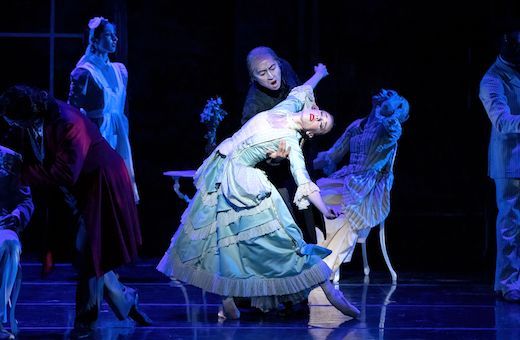Michael Pink’s Dracula, first performed in 1996, and restaged by the Kansas City Ballet tonight, is still a classic. I’m not one for horror films or movies, as a rule, but I thoroughly appreciated the immense energy and sheer bravura in this retelling of one of the most iconic of Victorian horror stories. This is narrative ballet, I felt, at its contemporary best. It was hard to look away.
Liang Fu was an outstanding Dracula: his stage presence was spine-tingling – regal and macabre, majestic and creepy at once – the merest hint of his pure evil enough to transform the whole atmosphere on stage. Notable were the stupendous lighting effects throughout, thanks to David Grill. What I found striking from the start was Fu’s extraordinary stillness – each move intentional and other-worldly, with the slowness of absolute power. His exaggeratedly opening reverence conjured up the V-shaped death-mime was vicious and disturbing, mocking victims and audience (if the two were indeed different).
Costume designer Lez Brotherston plays on his gendered ambivalence (the homoerotic overtones of the work are well-known): Dracula first appears, long haired, and in a crimson red gown, sailing down the stairs. Later he is in simple black. Fu brought his interpretative power to each of the pas de deux, with Johnathan Harding (well-performed by Lamin Pereira), that unlikely Englishman caught up in this murky foreign business, with Lucy (performed energetically by Kaleena Burks) and with Mina (a strong, robust performance from Danielle Fu). Never abandoning his expression of inhuman impassivity, the dances were magnificently charged, with Fu sinuous, swirling, seductive, aggressive – always dominant. His arachnoid climb down the sanatorium walls was the ultimate in creepy entrances.
I was reminded, as I watched, about how dance serves choreographer Michael Pink well as a metaphor for this work not just as its mode of expression. From the early sighting of the Romanian folk dancers – not ruddy-faced innocent peasants, as per the usual balletic script – but whirling dervishes, mourning a dead infant, and butchering a wolf, dance is imaged as a form of preternatural possession. Notably, in that scene, Harding, that most ordinary Englishman gentleman, is seated, watching them, nervously holding onto his brief-case, twitching uncomfortably at his collar, the very picture of confused respectability in the face of incomprehensible exoticism. When he removes his red scarf we think of someone getting hot under the collar, although he hasn’t even moved. Clearly, this Englishman, with his pork-pie hat, does not dance – does not dance, that is, until he does, that very night, seduced into wild kinetic expression by the three demonic female vampires, ferociously danced by Kelsey Ivana Hellebuyck, Taryn Mejia and Amaya Rodriguez. Later still, he is danced with by Dracula. Is he a passive performer? He is submissive but engaged.
The dance of the undead in Act 3, recalled in an evil inversion, the original folk dance of Act 1 – the movements still more whirling, incantatory, bloody. Compared to these dances, the tea dance at Northern English port town, Whitby, is a mild form, innocuous and, truth be told, rather dull, the merest parlor game of physicality. It’s no surprise that Lucy (Burks) cannot get enough of that dancing with her countrymen that, when Dracula arrives and the other guests crouch to the ground, she remains standing, trembling and en pointe, but ready (eager?) to engage in what comes, which will be her undoing.

That indeed was one of the things which the ballet did so well, play up the contrast between the normal and the paranormal. But even the contrast was nuanced: Luz San Miguel’s clever staging and Lez Brotherston’s sets suggest that the normal always looks somehow off. There are railway clocks askew, beds at an angle, night terrors, a maid who is imbibing, publicly, in the middle of the tea dance – small signs of a world deeply out of joint. You think you can depend on it, but you can’t.
Phillip Feeney’s marvelous score reflects this as well – there is a sourness underneath – any moment of reprieve is destined to be short-lived, and the scenes culminating ferocity are amplified by the force of the orchestra. Feeney calls on special effects to add another dimension to the ballet – eerie sounds from computers, tape-recording of vocals, synthesizers and bells which seem to come not from the pit but from somewhere in the auditorium. The final moments are shrouded with the ambivalence that characterizes the whole: their enemy dead, the three waistcoated gentlemen mourn their fallen brother in the background, while Mina, stage foreground, bathed in light, caresses the Dracula wound on her neck.


